On the night of June 5th, 1944, a force of 181 men commanded by Major John Howard lifted off from RAF Tarant Rushton aboard six Horsa gliders. Their force consisted of a reinforced company from the Oxford and Bucks Light Infantry along with twenty sappers drawn from the Royal Engineers. Their objective was to seize the bridge over the Caen Canal and subsequently secure the eastern flank of the Allied landings at Sword beach. Theirs was arguably the most critical piece in the entire D-Day invasion.

The Webley revolver was a break-open double action design that fired a relatively anemic .38/200 rimmed cartridge.
Any amphibious operation is tenuous until a lodgment is established. At first the advantage always goes to the defender. No matter the intensity of the pre-operation bombardment, the outcome ultimately turns on the fortitude of the attackers pitted against the fortitude of the defenders. This bridge was the choke point for German armor that might have attempted to reinforce the defenders on the beach.
The invasion, code named Operation Overlord, was indeed an iffy thing. Had the Allies hit the beaches and found them populated with the fully armed tanks of the German 21st Panzer Division then they very likely could have been pushed back into the sea. General Eisenhower, the Supreme Allied Commander, had actually prepared a letter assuming full responsibility for the failure of this operation had this been the case. Thanks to Major Howard and his 181 British Glider-borne soldiers this letter went unused.
Five of the British gliders landed as close as 47 meters to the objective at 16 minutes past midnight. Considering these glider pilots made a silent unpowered approach in utter darkness this represents some of the most remarkable pilotage of the war. These brave British soldiers poured out of their wrecked gliders and took the bridge in short order.
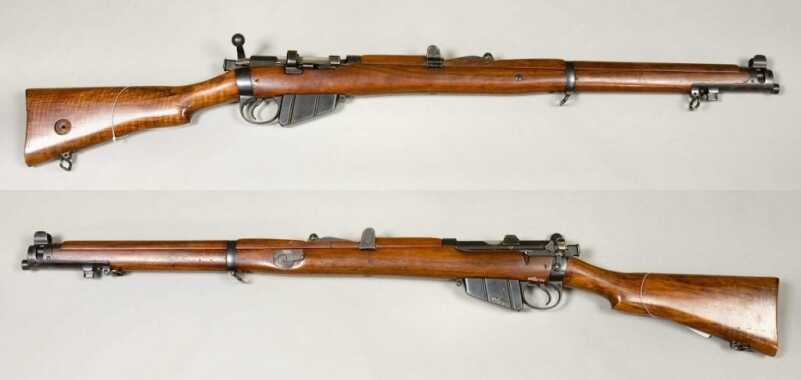
The Short Magazine Lee-Enfield (SMLE) was a superb bolt-action design that served the British well during the First World War.
Lance Corporal Fred Greenhalgh was thrown clear of his glider on impact and knocked unconscious. He landed face first in a shallow pond no more than six inches deep but subsequently drowned. Lieutenant Den Brotheridge stormed the bridge firing his Sten gun and throwing grenades until he was mortally wounded by German machinegun fire. Greenhalgh and Brotheridge were the first Allied soldiers killed on D-Day.
At around 0200 the lead armored vehicle of German 21st Panzer rounded a corner and drove between two buildings that defined the approach to the bridge. Alerted by the sound of tracks in the darkness, Major Howard had dispatched Sergeant Charles “Wagger” Thornton with the unit’s last operational PIAT launcher and two hollow-charge projectiles. Thornton covered himself in garbage and had been in place around three minutes when the first tank arrived.
There is a dispute as to the type of vehicle involved. It has been reported to be either a Panzerkampfwagen Mark IV or a Marder open-topped self-propelled gun. Regardless, no doubt thoroughly terrified, Sergeant Thornton loosed his PIAT bomb at a range of 27 meters and center-punched the vehicle, igniting its onboard ammunition. The destroyed vehicle subsequently effectively sealed off the approaches to the landing areas from reinforcing German armor. As a result, Sergeant Thornton’s single desperate PIAT shot very probably saved the entire invasion.
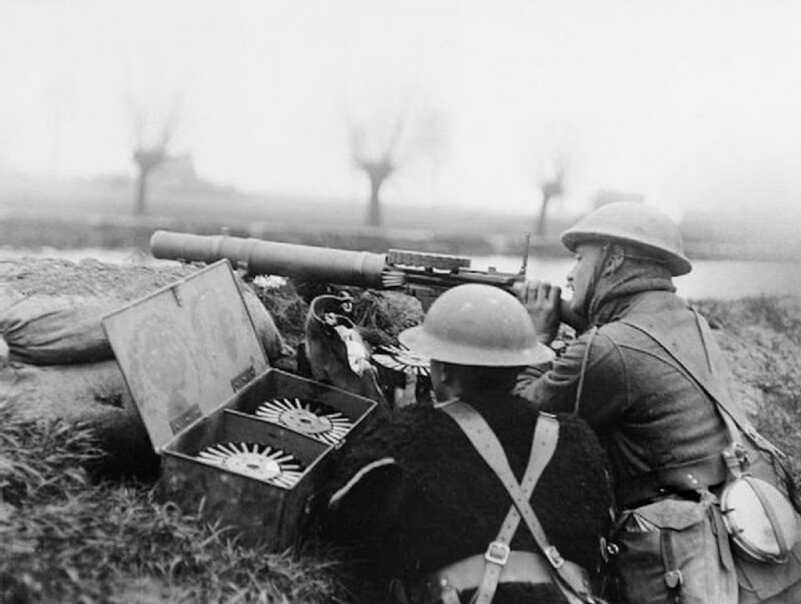
The Lewis gun was an American design that was used extensively during WW1. Obsolete by 1940, the Lewis nonetheless soldiered on in second-line applications throughout the war. The most distinguishing characteristics of the Lewis were its bulbous barrel shroud and top-mounted pan magazine.
Weapons
That the British Army survived the evacuation at Dunkirk is a legitimate modern-day miracle. While more than 300,000 troops survived, they arrived in Britain exhausted, demoralized, and bereft of their weapons. Desperate to refit and re-equip in the face of an expected German invasion, the English military leadership initiated a crash program to produce small arms in breathtaking quantities.
It is easy to disparage the quality of British small arms from the comfort of our living rooms. However, the British people rightfully feared imminent invasion. Had Hitler not foolishly launched Operation Barbarossa in an attempt to conquer Russia they would have undoubtedly seen German troops on British soil. As a result, the British endured some shortcuts in both the quality and design of their small arms. That they still fared so well is a testimony to the grit and tenacity of the British fighting man and his leadership.
Handguns
At a time when the entire world was issuing autoloading handguns, the British persisted in issuing revolvers that were state of the art during the previous world war. Given the desperate pressures under which they operated British industry simply continued producing the handguns they were already tooled up to produce. Webley and Enfield revolvers were morphologically similar. Both were break-open designs that incorporated an automatic ejector to remove empty shell casings. While some earlier versions were chambered for a powerful .455 round, most WW2-era versions were .38’s.
Early WW1-era Webley Mk I’s fired the rimmed .455 round. However, many were subsequently converted to fire rimless .45ACP ammunition by having the faces of their cylinders shaved down appropriately. Rimless .45ACP rounds were subsequently managed via moon clips. This conversion allowed the continued issue of .455 Webleys after the supply of .455 rimmed ammunition was exhausted.
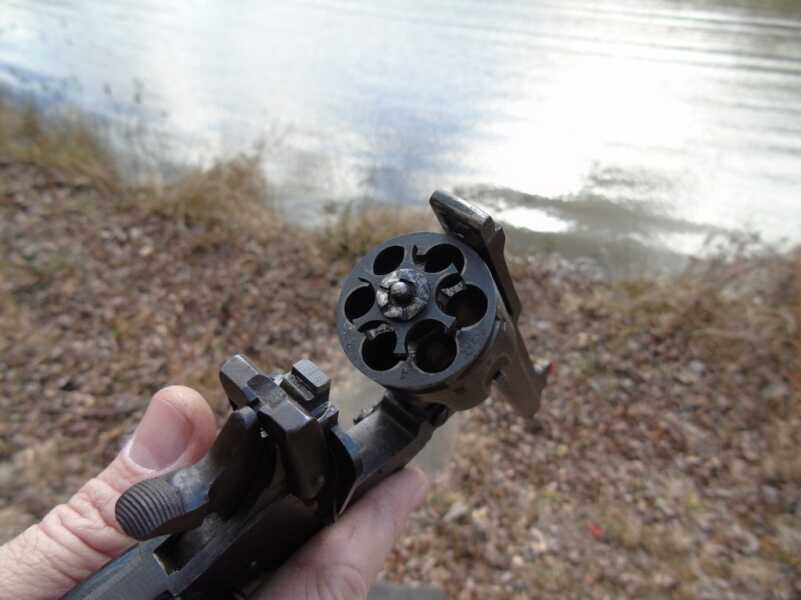
The star-shaped ejector on the Webley and Enfield revolvers automatically expelled the empty cases when the gun was broken open for reloading.
The most common WW2-era Webley was the Mk IV chambered for the .38/200 round. This round is 9x20mm and is interchangeable with the .38 S&W cartridge. By comparison the ubiquitous .38 Special is 9×29.5mm and much more powerful. The No2 Mk 1 Enfield fired the same round. However, the hammer was bobbed on the Enfield to affect double action only. This weapon was intended for use in tanks, aircraft, and vehicles for applications that might require that a sidearm be used one-handed.
The 4-1-1 on Handguns During Combat
Handguns of any sort seldom affect the big picture in combat. They serve as badges of rank or security talismans, but the pistol does not win wars. As such, though their revolvers were dated when compared to other autoloading designs, this made little difference in the grand scheme.
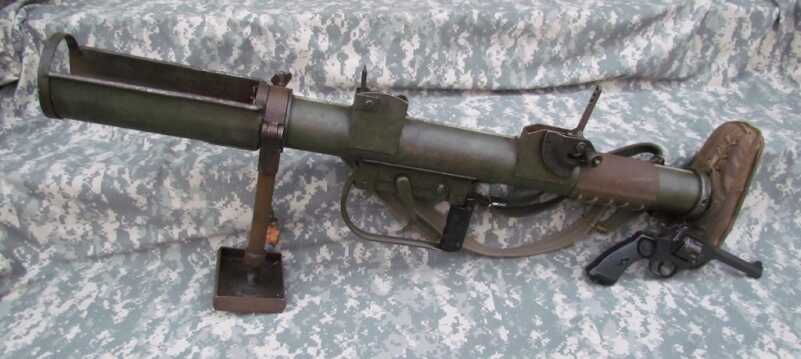
The PIAT was a monstrosity of a weapon that used a spring-driven piston to fire shaped-charge antitank warheads.
Rifles
The British began World War 2 with the SMLE (Short Magazine Lee-Enfield). This superb bolt-action design armed British Tommies in the fetid trenches of World War 1. As the SMLE cocked on closing it provided a greater rate of fire than other designs that cocked when the bolt was opened. As the scope of the war and its commensurate logistics demands grew, however, the British Army needed something cheaper and easier to produce.
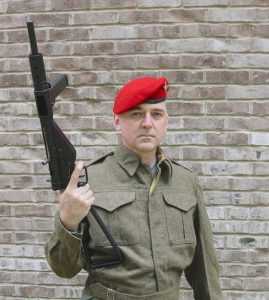
The British Sten gun was simple, inexpensive, and effective. Sporting a left-sided magazine and remarkably sedate rate of fire, the Sten was found throughout all combat theaters of World War 2.
The No 4 Mk 1 Lee-Enfield was a product-improved version of the SMLE. This rifle retained the 10-round magazine and .303 chambering of the SMLE. And it deleted the SMLE’s magazine cutoff and, ultimately, its complicated adjustable sight. The No 4 was heavier and slightly more robust than the SMLE, but it was much easier and faster to produce.
The rimmed .303 cartridge was obsolete by World War 2. However, like the Lee-Enfield rifle, this was what British industry was tooled up to produce. As a result, both the No 4 Lee-Enfield and its tired round soldiered on through WW2 and well beyond. Once again, the English were forced to make do with what they had.
Submachine Guns
The British had no general-issue submachine gun at the beginning of the war. They made do with expensive, heavy, and obsolete Thompson guns purchased from the United States. In desperate need of something inexpensive and easy to build, English gun designers Major Reginald Shepherd and Harold Turpin set out to contrive the ultimate mass-produced pistol caliber submachine gun. The name Sten is drawn from the first letters of the designers’ names along with Enfield.

The Bren Light Machinegun was arguably the finest LMG of the war. Portable and reliable, the Bren offered dismounted Infantry a mobile base of fire that could accompany troops in the assault.
Sten
The British produced the Sten gun using components produced in tiny shops across the island. There were seven marks and around four million copies rolled off the lines. Unit cost in WW2 was around $10 or $156 today. Most Stens used a simple drawn steel tube as a receiver and fed from the left side via a double column, single feed 32-round magazine. All Stens were selective fire. Most incorporated a rotating magazine housing that could be positioned to seal the ejection port from battlefield grunge.
Mk IIS
The Mk IIS included an integral sound suppressor, a revolutionary feature for the day, as well as a bronze bolt. The Mk III was the simplest of the lot and incorporated a simple welded on magazine housing and a pressed steel receiver. The Sten was not the most reliable gun on the battlefield but it was widely distributed through both British combat formations as well as underground partisans operating in occupied territories.
Machinegun
The Brits used Vickers and Lewis guns at the beginning of the war, some of which served until the armistice. The Vickers was an English adaptation of the same Hiram Stevens Maxim design that drove the German Maxim MG08 guns during WW1. Heavy, water-cooled, and imminently reliable, the Vickers was a superb sustained fire weapon when employed from vehicles or static mountings. It was useless in a mobile ground assault, however.
The BREN gun was arguably the finest light machinegun used by any major combatant. A license-produced copy of the Czech ZGB-33, the Bren fired from the open bolt and fed from top-mounted 30-round box magazines. It had a rate of fire of around 500 rounds per minute. The BREN gave the dismounted Infantry squad a portable base of automatic fire that could maneuver with dismounted ground forces. Though heavy by today’s standards, the BREN was rugged and dependable.
The PIAT
The weapon Wagger Thornton used to save D-Day was the Projector, infantry, Anti-Tank. This monstrosity of an anti-tank weapon was actually a handheld spigot mortar. The PIAT incorporated a spring-driven piston that extended into the base of its hollow-charge projectile. It would then ignite a propellant charge. The prodigious recoil of the shot should theoretically recock the heavy spring action. The PIAT weighed 32 pounds and had a maximum effective range of 115 yards. Sergeant Thornton later described the PIAT as “Rubbish, really” in a post-war interview.
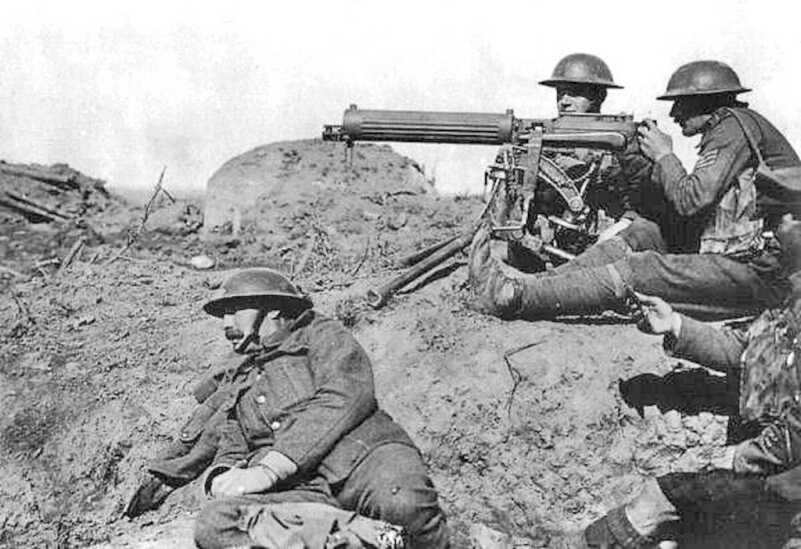
The Vickers machinegun was a water-cooled belt-fed behemoth intended to be fired from fixed positions.
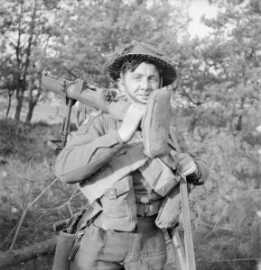
The PIAT was a monstrosity of a weapon that used a spring-driven piston to fire shaped-charge antitank warheads.
Gestalt
The British fought and won WW 2 with a hodgepodge of obsolete weapons mass-produced via a disseminated industrial base with their backs literally against the sea. While they lacked a semiautomatic handgun or an autoloading Infantry rifle, their Bren gun was enormously effective. And the PIAT did indeed save D-Day. In the final analysis, it was the men behind the weapons, and not the weapons themselves, that wrested control of mainland Europe from the grip of Nazi tyranny.





Many years ago, had the opportunity to speak with a German army veteran. According to him. It wasn’t any one nation that defeated Germany. It was the manufacturing capacity of the U S.
When the 38 S&W Enfields were imported, the story was that the bobbed hammer ‘tanker’ model was a stunt to increase sales and never saw action.
Amazing display of ignorance of WWII by some of the commentators…I guess they never heard of what Montgomery did in North Africa and in continental Europe, after the invasion.
In absolute terms Italy, the UK and the US had the smallest number of soldiers killed, and the Soviet Union, followed by Germany and Japan, the highest. This should suggests something about the actual involvement in battle, but the duration of WWII operations in different countries must be accounted for, with Germany’s being the longest and (presumably) Italy’s the shortest. (Civilians are a different story, and far more horrendous.)
But most of us like opinion rather than fact….an increasingly popular pastime.
Boche is the French term, the Tommies used Jerries when referring to the Germans. The French were called Frogs and the Americans were the Yanks. The Japanese were the Japs or Nips by the Americans soldiers but also in the Press and even in LIFE magazine. Russians were the Ivans. I like the Enfield 303, specially the smooth bolt action and the best version is the jungle carbine because it is so easy to handle and carry. They were fine rifles and still found at gun shows in very good condition for hunting or target shooting either informal or competitions for old military rifles.
Mr. Borrero Sir. Yes you are very correct. I do believe that the British also used the word “Huns” to designate the Germans.
Yeh, the .303 was “obsolete”. But lest we forget, during the Battle of Britain MOST of the planes that defeated the Germans were armed with the .303, specifically the Hurricanes and Spitfires. Listening to all of the whining, I realize the Brits did NOT take the attitude of “…Oh God, our guns are too old and puny to fight these superbly equipped barbarians -we need to surrender NOW…” It was more of a “We’ve a job to do with the tools we have at hand -let’s get to it!” -and they did. They drew and held Travis’s line-in-the-sand while the US geared up (with a lot of argument about it) to first provide them with material, and then the rest is history………
Dear Professor and learned and esteemed scholar : ” …the Bosche…” I think NOT. Try the Boche, perhaps ?
Could someone give a story behind the 303 Endfield with the enclosed internal magazine? I believe Sargent York used this one.
Thanks
Sgt. Alvin York carried a U. S. Model 1917 “Enfield” rifle in .30-06 cal, same as the U. S. Model 1903-A1 “Springfield”. The Model 1917 was originally produced by some US manufacturers at the Pattern 14 rifle for the British in .303. It had an exceptionally strong action. When the US became involved in WW I, our factories modified the Pattern 14 to handle the US .30-06 cartridge for US troops. We used them as a secondary rifle into WW II. Many of the Philippine Scouts were armed with the US Model 1917 during the Bataan battles in the Philippine campaign at our beginning of WW II.
The SMLE (Short Magazine Lee Enfield) was a British designed rifle, derived from their Lee Metford, in .303, a rimmed cartridge, designed in the 1880’s. The SMLE went through a variety of modifications through the 1950’s when they adopted a “self-loading” (semi-auto) rifle.
Sgt. York used an American made Model 1917 Enfield in .30-06, not a British SMLE in .303. Totally different rifle.
According to Interviews given by Sgt York himself, early on he traded his 1917 Enfield for a Springfield, 1903…. In later years, his son related his fathers disdain for the Enfield’s Receiver sight.
Interesting. Many British riflemen felt the same way about the receiver sight on the No 4 Enfield.
York hated the 1917 American made Enfield with a passion because of its peep sights which he said prevented him from quickly acquiring a sight picture and then firing the weapon quickly before an enemy could shoot back at him.. He managed to secure 1903 rifles for himself and his entire outfit. If you want further reading on how poorly made the U.S. Enfield was by all means read the book “The1917 Enfield by the Author Ferris available through the NRA in paperback and at a low cost. It has many previously unknown and shocking facts on the shoddy manufacture of this rifle and one lot guns actually blew up due to an inferior and defective grade of steel. So it was not just the 1903 rifle that blew up because of shoddy workmanship and heat treating but the Enfield did as well and some were actually later sold to the public against the warnings of U.S, Military ordinance officer.. Another interesting fact brought in the book is that the 1917 rifle was for most of its production life not even made off of blue prints but drawings and as a result improvements to parts resulted in the newer parts not fitting the older rifles when they needed repair. The workmanship was so bad on these rifles that the Author who had 11 of them for study studly one night when looking at them from across the room went into shock when he realized that all 11 rifles were all of different lengths. He points out that at the beginning of WWII when the U.S, was desperate for rifles that the 1917 was such a hated rifle the Government set about giving millions of them away to Greece and China rather than re-issue them and use them in WWII for U.S. troops. Remington ended up getting a contract to build more 1903 Rifles during WWII and even though they had build 1917 rifles during WWI the Government wanted no more of them in WWII. The Author also details the great controversy about the 1917 Rifle before the U.S. Adopted it in WWI and the resistance to adopt the rifle that came from many Military people in high places which included lengthy articles in the Nations News Papers condemning the design of the rifle, now all but forgotten by even many arms historians.
The British soldiers didn’t win anything except a few battles, mostly minor. The British code breaker Alan Turing deserves 1/2 the credit, and the other 1/2 goes to American engineering, manufacturing, and citizens who without arms, airplanes, ships, supplies and tanks, the Russians and Brits today would both be speaking German. Facts are facts…funny how that works.
you want to know another funny thing MB,,the British were the FIRST to go fight Hitler and the Nazis,then Canada helped,the United States REFUSED to enter the war,UNTIL the battle was brought to THEIR country at Pearl Harbour,,that’s also funny how that works,so please keep your deminishing comment on Allied countries to yourself,you might also want to do a little research and see what the Canadians role on D-Day was,you might be surprised,ALL countries played a vital role in destroying the AXIS and Japanese forces,so keep your superior attitude to yourself,just makes you look bad,
Never said anything disparaging the Canadians or even the Brits soldiers. They were on the verge of losing the war. Doesn’t make a difference who got into the fight first, it’s who finished the fight. I was pointing out Britain’s major contribution was cracking the Egnima, and without that, the war might have lasted 2-3 more years, years the Brits didn’t have. And certainly would have cost many more lives. So please get over yourself.
Doesn’t matter who likes it or who doesn’t, we were all in it together and a damned good thing we were. Let’s cut the crap and recognize that. What would the vaunted P-51 Mustang been worth without that great Rolls-Royce Merlin engine? Not much! Everybody sacrificed, suffered, and gave their best. As the saying goes, “All gave some, some gave all”!!
The Brits whupped Rommel in N. Africa in several major battles so your comment that they won a few “minor” battles is disingenuous at best, pure ignorance at worse. The UK lost almost 400,000 troops, about 1% of it’s population, in WW2. Methinks you should learn real historical facts before making dumb comments.
Oaf < To paraphrase a great general, You don't win a war by dying for your country, you make the other SOB die for his. The Germans did that to the Brits. The Brits almost lost 300,000 troops at Dunkirk, but they left all their weapons behind. Americans gave up their rifles to help the Brits defend their island, and after the war, they thanked us by confiscating them and destroying them instead of sending them back. The British did win at El Alamein, but Africa was just a diversion, we would have beaten the Germans even without setting foot there. It was to gain time to stage for Normandy. I know a something of history. They did their part, but they were far from winning if we didn't enter the war. There is no glory in war, only death and misery.
Although often attributed to him, Patton himself probably never said that, but George C. Scott – in the movie “Patton” – certainly did.
No mention of the Soviet Union? They lost 16+ million fighting off Hitler’s Eastern Offensive. This gave Eisenhower time to plan the Normandy landing.
Some observers inside and outside the USSR believe we slow-walked the invasion to weaken the Soviets, because our planners had determined that the Russians would be our next adversary.
Indeed, when the Pacific war ended, the Japanese went from being subhuman monsters to our valued partners in resisting Russia in about 2 seconds.
Without the USSR’s ferocious resistance we might all be speaking German.
Good response and here is some more shocking facts. Russia fought the cream of the German Armies that invaded Russia. When “D” Day came about the Americans and British faced either worn out shell shocked German Troops sent to Western Europe to recuperate or they in many cases actually did not fight Germans at all but “volunteer troops” from all over Europe. On the Beaches at “D”Day many of the Allies troops that were machined gunned down were actually killed by “Russian Concentration Camp volunteers” fighting for the German Army as they did it to avoid being starved to death or gassed in the Concentration Camps. Another interesting fact is that the troops that fought so hard to protect Hitler in His bunker from the attacking Russian Troops were not German troops at all but volunteer French Foreign Legion Troops. All this later has been well covered up or ignored or swept under the rug of History as too embarrassing for the Allies to admit to especially the French.
In conclusion despite a small amount of “lend lease aid” (a lot of it never used) it was really the Russians that won WWII in Europe not the Allies. Even the great Allies bombing campaign in the air war against Germany was a colossal failure as the Germans actually produced more weapons in the last year of the war than the previous 5 years of war its just that they lost so many troops on the Russian front and so many trained cream of the crop pilots that all that equipment did little good and with the Russians capturing the oil fields of the Caucuses and the oil files of Polesti in Romania many German tanks and planes simply sat idle.
The codes for the Enigma machine were not broken in WW2, they were hacked at a great cost of lives.
Informative and interesting article. Thank you for sharing.
“The No 4 was heavier and slightly more robust than the SMLE…” No, they are about the same weight, 9 pounds or so. The No. 4 was “…easier and faster to produce” however, because of the reduction in the number of parts required, while not the complexity of the machining, to produce it.
“…it was the men behind the weapons, and not the weapons themselves, that wrested control of mainland Europe from the grip of Nazi tyranny” is quite correct. “While they lacked a semiautomatic handgun or an autoloading Infantry rifle,” however, is a ridiculous statement. While Germany fielded semiauto handguns, they relied on the tried-and-true bolt-action K98 as their primary infantry rifle. The USA was the only nation with first-rank autoloading battle firearms.
The guy with the Bren looks like Michael Palin from Monty Python.
“The Brits won the war”. Really? They contributed. I believe that the German MG42 was probably the best “light” machine gun of the war. (jmnsho)
One could say England won the war by staying uninvaded long enough to become our staging and launching point for the invasion of Europe.but,the usa and the ussr were the top 2 settlers of Hitlers hash! The brits had a 3rd place contribution of the actual fight.
Brits won nothing, moron!
Ok, now who is being moronic. The Desert war was a perfect example of the tenacity of the Brits and their allies against a superiorly armed enemy. The U.S. was nowhere to be seen there at that time.
Your foolish nonsense is a slap in the face of the men and their people back home, and especially the Desert Rats and the Rats of Tobruk during the siege of that city.
Educate yourself on History before making silly and demeaning comments.
The British did win at El Alamein, but for the most part they could barely hold ground against the Nazi war machine. Every country contributed something, the Brits greatest contribution was their ability to break code.
What a lot of nonsense.
The British Army threw the Germans and Italians out of the entire North African Theatre of Ops.
From June of ’40, until Operation Torch in Nov of ’42, they did it on their own.
All we did was sell them arms and munitions, and made a ton of money.
So you’re giving credit to the U.S. for what, a 6 month involvement, during which time our first engagement was an embarrassing near total route and chaotic event?!?!?!?!
By that time, the German Army was mostly fighting a running retreat, due to the licking the Brits had given them in the previous 2 years and Hitlers lack of enthusiasm for that front, and his desire to push the Eastern Front.
And without those arms and ammo we sold/lent/gave/gifted whatever, the Brits would have been in real trouble in North Africa/Egypt. Guess you didn’t read my statement, American engineering, manufacturing, and citizens who supplied arms, airplanes, ships, supplies, fuel and tanks, without them the Brits would most likely been defeated,
The MG42 was not a “light MG” but was a crew served weapon. A true light MG is one designed for one man operation. While the MG34 and 42 could be operated by one man for a short time, it definitely is not a LMG.
Oh well hey, “The Battle of Britain” was just a minor skirmish and the decentralized independent radar was not very helpful at all huh?
I’ve seen many a picture of WWII Brits with Browning Hi-Powers.
Great article as usual Doc, thank you.
A great article – Thank you!
The Home Guard, regularly ridiculed, were mainly ex WW1 soldiers too old to enlist. In Greenwich a small detachment used their SMLEs in rapid fire to bring down a German Bomber over Greenwich. At Dunkirk that method was used to try to bring down diving Stukkas. That must have been terrifying to stand there in a group rapid firing with a rifle.
In Sept 1939 my father was marching through France as 2nd Lieutenant in the Durham Light Infantry, part of the BEF. He was evacuated wounded in May 1940 from Dunkirk having spent 5 days on the beaches under attack by German planes mainly. He was armed with a .455 Webley from WW1. He said the worst thing he had to do was shoot a wounded horse. PS when Germany lost the Battle of Britain they could not attempt a seaborne attacked. The RN vastly outnumbered them in ships. My Aunt was one of the girls who manned the Fighter war room controlling the flights to intercept the bombers
The most important action of D-Day? Really? Good grief. Try telling that to the men who assaulted Omaha Beach…
Well HMS Belfast led the task force and fired the first salvo. Omaha beach was made worse as the US rejected the mine flails and some other technology the British used as “not necessary”. The practice assaults were made on Slapton Sands in Devon. Some 900 US soldiers died under a surprise attack by E-Boats. A US Tank is in the carpark at Torcross in memory of them.
Not to mention US bombing runs and naval artillery fell too far inland missing their targets on the beach.
You didn’t read the article, did you. The author posits that without that German armoured vehicle being knocked out on the approach to the bridge at Caen and subsequently blocking it, the D-Day landings could have been severely jeopardised by the free movement to the landing areas of large amounts of German armour. He has suggested that because of the tactical importance of this one tank kill, the landings were “easier” than they might have been.
I’m pretty sure every person on the amphibious landing would have recognised the value in that pivotal engagement had they known at the time.
“…to beat back the Bosche”? Did you mean “…to show Gerry what for?” Oddly, the SMLE and its variants were somewhat more effective than the K-98 due to cartridge they fired. The German 7.92mm round was a full power cartridge and had a nasty recoil if you hadn’t buried the stock in your shoulder like you should. The .303 rimmed was a medium power cartridge that not only was more intrinsically accurate than the 7.92 but generated less of a kick than the German round. This was important when one is firing a Vickers or a Lewis machine gun – less recoil means less bounce and better accuracy.
Virtually all the British weapons of WWII were near perfect for combat, being simple, reliable, accurate enough, easily built and most of all, cheap to make. Since Great Britain was all but bankrupt when the European war ended, the latter was very important.
You mention that the sights on the SMLE vs. those on the LE No.4 Mk1. Yes, the sights on the SMLE were more costly to make, but they supported the spooky accuracy the SMLE was capable of providing in the hands of a competent shooter. I’d have no problems recommending the British armory in WWII as being the best available at the time. Being a small and not-very-wealthy island nation apparently stimulates creativity during wartime, at least in Britain’s case.
I didn’t see anything about the jungle carbine
Probably because there wasn’t too much jungle in Normandy – apart from the hedgerows.
And why was Britain (no longer Great) bankrupt after this mid century conflict? Maybe because Roosevelt and most of the American leadership didn’t believe Britain could survive, and didn’t want to bet on a losing horse. Every single available offshore island was signed over to US ownership, and the last of Britain’s gold reserves were shipped from South Africa to the US. Only after the defeat of the Luftwaffe during the Battle of Britain was Lend Lease initiated to provide miltary aid without payment. Of course, after Pearl Harbor, the us couldn’t do enough to help. Better (very) late than never.
Then why are those Islands in the Caribbean still UK administration territories. Check the modern maps and you will see next to them (UK).
Are you kidding? FDR was champing at the bit to get into the war and help out his cousin Winston, but he knew that without a credible threat to the USA – and perhaps even then – the overwhelming isolationist sentiment in America would mean political suicide if he brought us into the war.
If they had today’s 24/7 “news” coverage back then, you can be sure that Lend-Lease would have been fixated upon as stretching, if not entirely violating our “neutrality,” and while it has been supposedly debunked many times, the notion that Churchill’s intelligence people knew of but did not inform us of the Japanese plans to attack Pearl Harbor (to use the currently-popular phrase) “in collusion with” FDR might have delayed our entry into the war, and perhaps even kept us from fighting anyone other than the Japanese.
Yeh, the .303 was “obsolete”. But lest we forget, during the Battle of Britain MOST of the planes that defeated the Germans were armed with the .303, specifically the Hurricanes and Spitfires. Listening to all of the whining, I realize the Brits did NOT take the attitude of “…Oh God, our guns are too old and puny to fight these superbly equipped barbarians -we need to surrender NOW…” It was more of a “We’ve a job to do with the tools we have at hand -let’s get to it!” -and they did. They drew and held Travis’s line-in-the-sand while the US geared up (with a lot of argument about it) to first provide them with material, and then the
rest is history………
*** Had Hitler not foolishly launched Operation Barbarossa in an attempt to conquer Russia they would have undoubtedly seen German troops on British soil. ***
far from certain. the germans had no landing craft to cross the channel, the kriegsmarine was inferior to the royal navy and knew it, and the luftwaffe could not achieve the first objective and linchpin of the plan, air superiority. hitler turned to barbarossa because operation sealion could not be mounted.
correct
This is a complicated issue. Hitler never intended to invade Britain. He had a lot of affection for the British, regarding them as fellow Aryans, of German descent. And remember, he visited his uncle in Britain before World War One. He also never expected Britain to declare war along with the French when he invaded Poland. But he could also never tolerate any form of opposition, and he considered his attacks on Britain as appropriate punishment for their temerity in resisting his invasion of France. He had always desired to invade Russia, as part of his loathing of Communism and the “untermenschen” he wanted to eliminate to make room for German expansion eastward. He had even written this intention in Mein Kampf. But nobody believed him at the time. He also fumed at France and never forgave them for the Versailles Treaty. He could have retained most of Europe and sat still for a year or two. He made not only one but two major errors. He declared war on the USA after the Japanese attacked, and then invaded Russia. Both assured his doom. He then took charge of his military, and this guaranteed his downfall due to his extremely limited military talent. Churchill forbade any assassination attempts because he could see that Hitler was his own worst enemy. Thank God we have no modern equivalent.
I have had the chance to visit Pegasus Bridge. Fascinating little museum and a must see place if you are touring the Normandy battlefields. The original bridge is set off to the side and you can walk it and see where the bullet strikes were from the battle, and there are some great artifacts in the museum itself. Also recommend reading Pegasus Bridge by Stephen Ambrose.
Some incredibly brave men did great work that night, both there and everywhere else the Airborne troops landed.
I too enjoyed this article, very informative for both world history and as well for firearms history.
P.S. the word “eminently” (very) should be used instead of “imminently” (very soon) reliable. Yeah I had to look it up.
Substitute “The Commonwealth fought and won WW2” instead of “The British fought and won WW 2 ” and you have a really good article.
More like,”they watched the U.S. win the war for them”.
Spot on.
Agreed; the British paid a terrible price, but the USA won that war for them.
Yeah, cheers for rocking up a bit late as usual. Once you’ve worked out which way the wind’s blowing…
you have watched too many movies
American logistics won the war for all the Allies.
Statistically this is not true. Nine out of every ten Germans killed during World War Two died with a Russian bullet or shell fragments in them (or maybe the severe cold did it). Nine out of ten Japanese who died were killed by the Chinese. Western perspectives of this war are massively skewed because we simply never saw most of the actions fought. No doubt our troops fought extremely bravely and skillfully, but if American and Commonwealth troops had faced the full force of German and Japanese forces in their entirety, they would have been slaughtered. Those are simple facts. Because both Axis powers decided on wars on two fronts, they diluted the forces available to face the Allies, and suffered accordingly. Because they emphasised their wars of conquest, they were unable to effectively defend themselves against attack. Had they retreated more effectively and conserved their forces, there would have remained a question of who would have won. But they didn’t. And they lost. Lucky for us.
While your “statistics” may be correct, you forget that the USA’s “Arsenal of Democracy” was largely, if indeed not entirely responsible for supplying the Russians and Chinese with both the weapons and ancillary support that allowed them to pursue (to paraphrase your comment) their “brave and skillful” fight against the Axis powers.
“Nine out of ten Japanese who died were killed by the Chinese.” Methinks you ought to recheck your “stats” before posting such an erroneous “fact”. More Japanese troops, Army and Navy, were killed in the Philippines alone than in all of China. I don’t think there were many Chinese troops fighting the Japs in the Philippines. Add in the other Pacific theater battles and they by far exceed the total losses by the Japanese in China. Nine of of ten is just ignorance.
might want to do a little more research,you ‘ll find that the Canadians won a large portion of battles as well,not to mention the Netherlands who still to this day celebrate the Canadians win there,so get off your high horse and recognize that the US is far from being the only one responsible to winning the war,not to mention the Canadians were the FIRST to send planes to the south seas to fight Japan,the US was still REFUSING to enter the war,bet they rethought that idea after pearl Harbour,sometimes we ALL have to be in to successfull .notice they dont just sit back anymore,they learned a hard lesson and now go charging in,
Good article but can I direct you to the existence of the John Ingalls produced Browning Hi-Power?
I found the article very interesting, wondered at the possibility of finding some of the rifles for sale
Search GunsAmerica.com.
The Lee-Enfield SMLE rifles aren’t hard to find, although many have been sportorized. Most Commonwealth countries manufactured them and—during World War I—a number were manufactured in the U.S. Conditions vary. Some gun or pawn shops may occasionally get them. I bought mine online. It was made in India in 1963. I really enjoy mine but have had to work on it to improve reliability and accuracy, mainly due to its having been stored.
The prices are becoming hideous on all ww2 long guns!